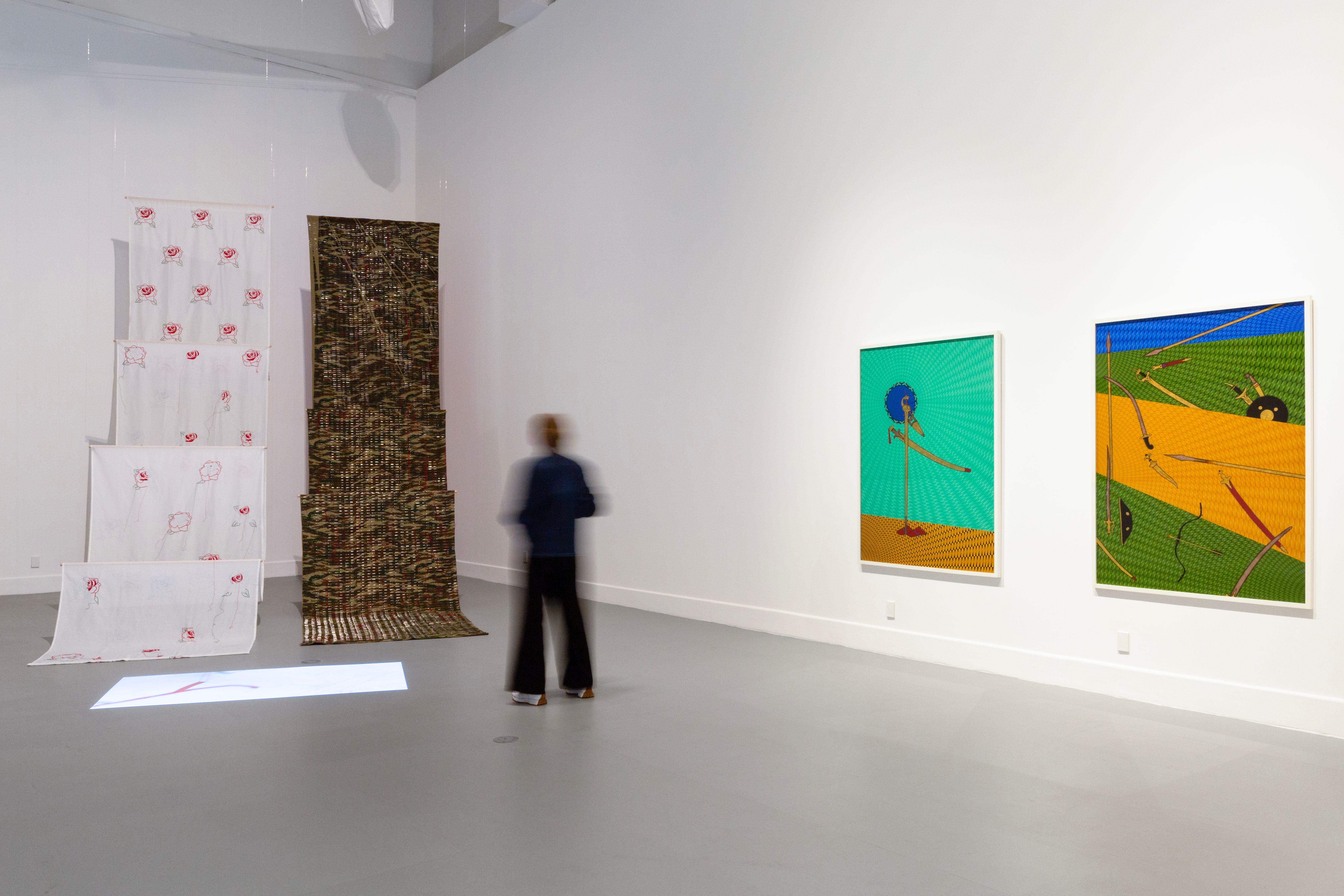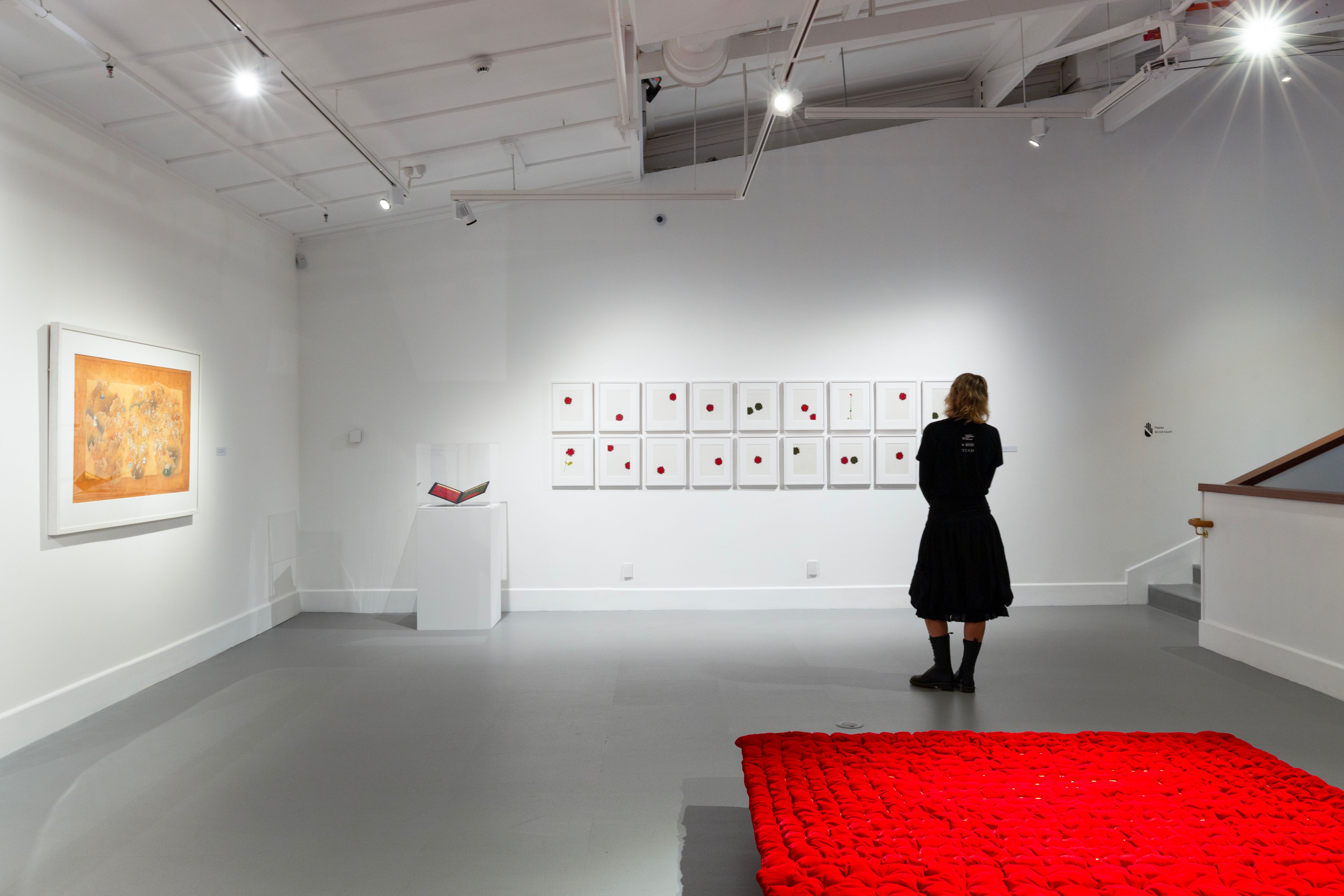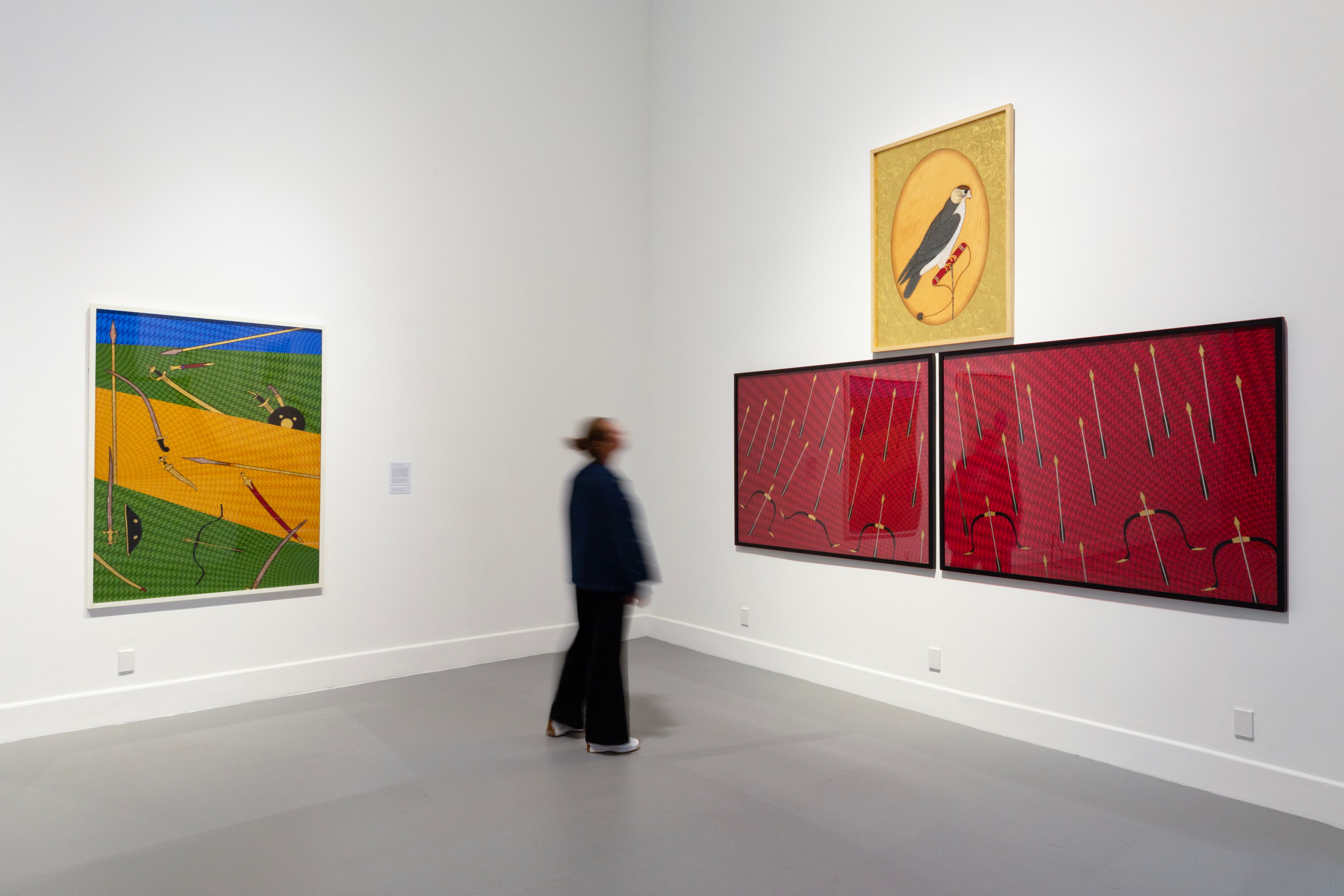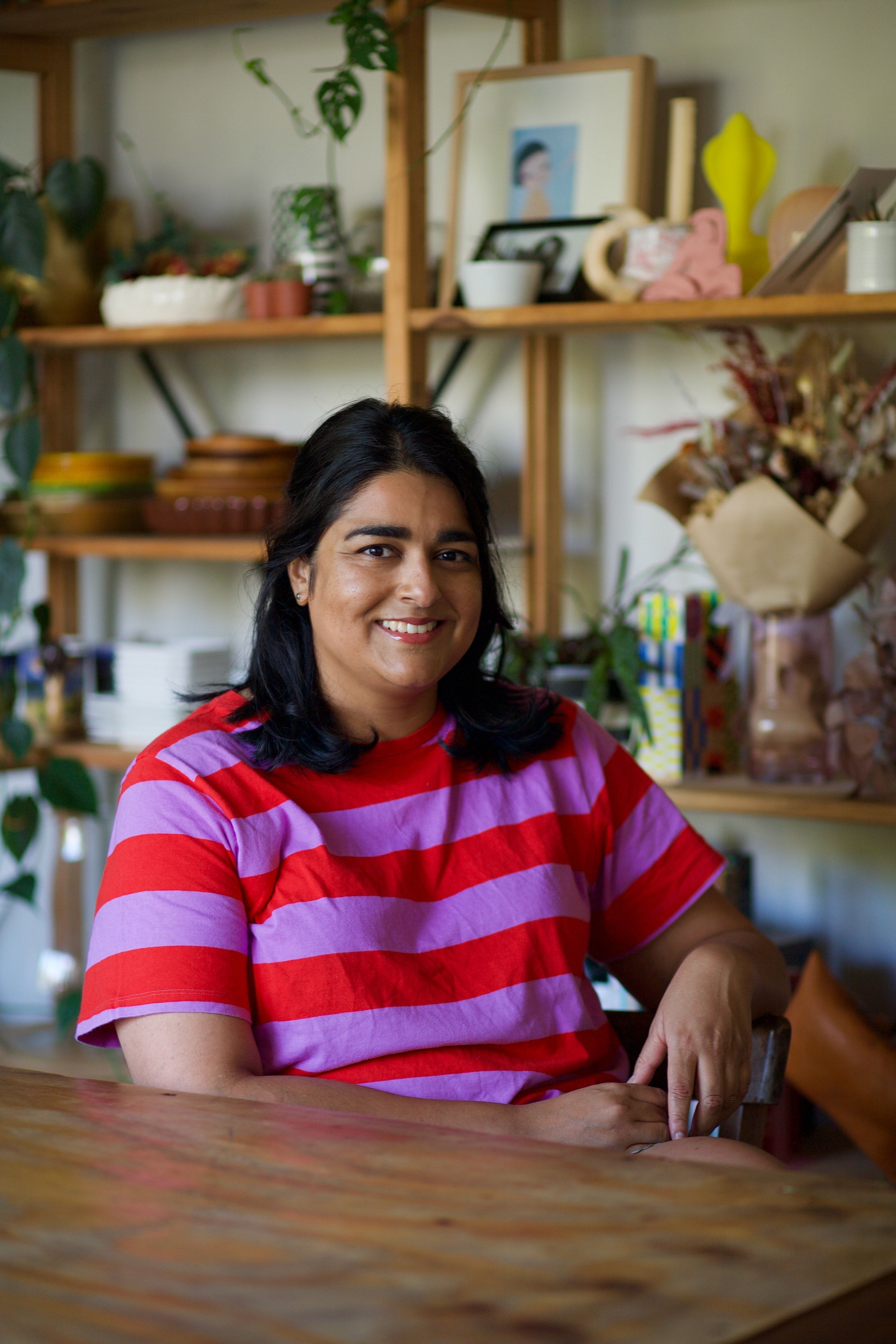Close to Home: Response to Aisha Khalid’s I Am And I Am Not
Sita Narsai walks through Aisha Khalid’s exhibition I Am And I Am Not at New Plymouth’s Govett-Brewster Art Gallery, and reflects on its relationship to colonial histories, migration and being in the South Asian diaspora.
I recently read (saw on TikTok) that South Asians make up one of the largest diasporas in the world, the result of migration – both forced and chosen. It is because of this reality I find myself, a third-generation New Zealander of Indian descent, responding to the work of Pakistani artist Aisha Khalid’s I Am And I Am Not, a retrospective of her work from 1993 to 2021, currently on display halfway around the world at New Plymouth’s Govett-Brewster Art Gallery. The retrospective, curated by Masuma Halai Khwaja, covers the wide range of Khalid’s work, from miniature paintings to books and tapestry installations, and, more recently, video installations.
I arrive early for the artist’s talk and tour on the opening day of the exhibition so I decide to have a quick look around before it starts. The first work I encounter is Two Worlds As One (2016) – a tapestry installation in which two long, lush fabric panels are suspended between the old gallery and the new. As I stand below them, they glow a rich deep red that exudes authority. It takes me a moment to realise the intricate gold embroidery is actually pinheads – thousands of gold dressmaker’s pins pierce the fabric – their sharp ends coming straight through the other side. In their multitude they looked like fur, but the initial softness of the work has been instantly replaced with a newly revealed edge and sharpness. I still want to run my hands along the back – but now with caution. I spend a lot of time with these pieces – taking photos, trying to get a good shot to show how the pins come through. My phone camera can’t do them justice.
Installation view. Photo credit: Cheska Brown
The tour starts on the mezzanine between staircases. Khalid is a warm and generous guide. She takes us through her miniature works; they are beautiful and quietly political. Khalid was formally trained in Indo-Persian miniature painting at the National College of Arts in Lahore. It’s a course that requires students to make their own brushes (from squirrel hair), paint and paper. Human figures and floral motifs were traditionally a trademark of miniatures, the format originally created for books to depict historical events or poetry. Khalid takes this tradition and imbues it with her own feelings and contemporary views to examine women’s position in society – the continual pressures and domestic expectations they face. The paintings play with perspective – curtains and veils are used to create an interiority on the flat surface of the wasli paper. Discipline is essential in miniature painting and this is seen through the meticulous attention to detail in works like One Point Perspective (2002) and Form X Pattern (2000). Khalid says that she would spend hours and hours on one painting, repeating the same act over and over, one square inch by one square inch – an act she finds meditative.
Up the stairs sits Comforters (2008): a bright-red puffy fabric is laid across a low plinth, the fabric is embroidered not with thread but with long gold pins to create a quilt-like landscape. Despite the pain it may inflict if used, the work reminds me of the soft gadla (Gujarati for comforters) my Bha had shipped to New Zealand from India for my mum and masis (aunts) as children. They must have been made extremely well because my brother and I then inherited them for our childhood beds. Distracted by this memory, I return to the present, where a little girl who had been peering down at the quilt as well runs over to her mum and mutters, “It’s not magic.” Disappointment shades her face but a smile appears on everyone else’s when we realise what she’s said.
Khalid says that she would spend hours and hours on one painting, repeating the same act over and over, one square inch by one square inch...
Geometric shapes play a major role in Khalid’s work, from the gouache and gold-leaf spiral paintings of The Garden Of Love Is Green Without Limit (2019) to the Japanese kintsugi-inspired works of More Beautiful For Having Been Broken (2018). The shapes were inspired by the floor tiles of Khalid’s childhood home in Sindh – the farmlands of which continue to hold fond memories for her. Due to the ethnic tensions in the area during her teenage years, Khalid and her family were forced to leave everything behind and relocate to Lahore. The family had only just arrived in Sindh two generations earlier when the Punjab region was split in two because of Partition – an event that continues to have a long-lasting impact on the region and its diaspora. The Indian subcontinent, which had been the ‘Jewel in the Crown’ of the British Empire for nearly 200 years, became something they no longer had the resources to control – especially after World War 2. During their rule, the British used ethnic, religious and regional tensions to divide and control the country politically. In 1947 they officially left, granting Independence – but, the country was to be partitioned in two: the Hindu majority of India and the Muslim majority of Pakistan (and then later Bangladesh). This initiated the greatest human migration in history. It is said that 15 million people, minorities in their home provinces, made the journey to these newly designated countries; many were displaced without homes or jobs, ethnic and religious violence spread, and it is estimated one million people died during this time.
The legacies of colonialism run through the exhibition. The work Name Class Subject (2009) takes the form of a book; it explores the continual hold of the English language in post-colonial Pakistan, how it creates a hierarchical class divide of those who can speak it and those who can’t. From left to right, the book is in English, and when read from right to left is in Urdu. This hits close to home: my family had started to leave India before Partition – men were able to migrate to countries within the British Empire and, as a result, three generations later, the words of my great-grandparents are rarely spoken. I know a few key words, but not enough that I’d be able to have a conversation (trust me – I once tried to buy bangles in India with little success). I’m filled with a sense of loss and shame – a mild identity crisis, a feeling of what could have been follows me as we continue around the gallery.
Installation view. Photo credit: Cheska Brown
We move to the level above, where the focal point of the exhibition, the tapestry piece The Garden Of Love Is Green Without Limit (2019), hangs from the ceiling to create a floating cube. It is an installation made of four rich, emerald-green fabric panels weighted by pins as embroidery. Pinned birds fly anticlockwise and we are encouraged to walk around it and follow their journey, just as those who make the pilgrimage to Mecca walk around the Kaaba. There is a duality in these pin works: Khalid follows the teachings of Sufism, believing that without pain you cannot be kind, generous or enlightened. Pain allows you to connect spirituality to yourself. There is no beauty without pain. The title of the retrospective, I Am And I Am Not – named after the poem of the same name by the Persian poet Rumi – echoes this duality between the physical world and the spiritual.
As we move around the exhibition and down the stairs, the scale of the painted works increases. The calculated geometric shapes of I Am And I Am Not (2019) see the miniature-style format enlarged. This time, the work focuses on war and division. Figures prominent in earlier works have been removed and we are left with weapons displayed abstractly in action on a geometric background, illustrating the futility of life in the quest for power and that history will repeat itself no matter who wields the sword.
Khalid was taught to embroider and stitch at a young age by her mother, and both of these mediums appear in some form across all her work. In Time and Patience (2013), two lengths of fabric roll towards a video projected onto the floor. The left, in white, has red embroidered flowers flowing down – some finished, some unfinished. The right, in a camouflage print, is pierced by long steel needles. Both are left in an incomplete state. The work speaks to the heavy taxes placed on Bengali muslin by the British during the Industrial Revolution, effectively destroying an industry and the livelihood of hundreds of thousands of Bengali. In the video work Conversation (2002), two screens play at the same time – a conversation between the East and the West. The piece was created while Khalid was completing her master’s degree in Amsterdam. A brown hand embroiders a rose on the left screen, while a white hand brutally unpicks all the work on the right. It is a direct response to the stereotyping and societal shifts Khalid experienced in a post-9/11 world as a Muslim woman creating art in a country that had no knowledge or understanding of her traditions and culture.
Installation view. Photo credit: Cheska Brown
We end the tour seated between the two screens of I Am And I Am Not (2020) for a Q&A. It’s an all-encompassing work documenting a performance staged in 2017. The left projection shows musicians singing the poetry of Shah Abdul Latif Bhittai, an 18th-century Sufi saint. On the right we see Khalid in a state of meditative creation, repeatedly and rhythmically pinning fabric. On the centre wall sits a pinned work that simply features the word ‘Ishq’ (love) in gold pins through gold fabric. It is a work best experienced with the supplied headphones, the music played reminds me of one of my favourite Bollywood songs, ‘Aaya Tere Dar Par’, a fittingly intense and repetitive song about love and longing.
Afterwards, a group of us wait to speak with and thank Khalid. The curator, Masuma Halai Kwaja, greets me and the others. There’s a familiarity I have only ever experienced with other South Asians that runs through our conversation. The New Plymouth Pakistani community is fully engaged: the pride they have in hosting Khalid and her works in their city is palpable. They are planning a dinner for her later that day, breaking their Ramadan fast once the sun sets. The group poses for a photo: I’m encouraged to join. We chat away in a mix of Hindi and English, but I don’t feel ashamed or embarrassed for not fully understanding. Instead I feel a great sense of community: this is the diaspora in action. We come from a similar culture and shared history, united now by Khalid’s work. Identity crisis averted.
Aisha Khalid: I Am And I Am Not
1 April – 16 July
Govett-Brewster Art Gallery




